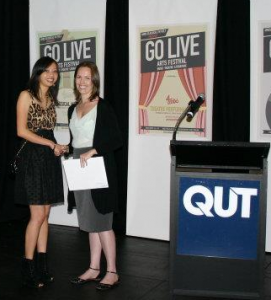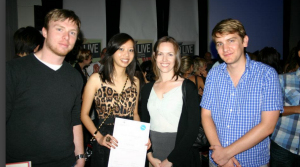GUEST POST by Talia Yat: My tips on web strategy
Bluewire Media has an annual web strategy prize for QUT students. The student who the won the prize in 2011 was Talia Yat and here she shares her tips on web strategy. If you’d like to get in touch with Talia, please feel free to do so!
Enter Talia…
My tips on web strategy

Talia Yat with Angela Logovik from Bluewire Media
Designing and developing a website can be challenging and often a time consuming process. When it comes to deploying your website, you want to make sure that it actually serves your purpose and is seen by your intended audience.
I recently redesigned my portfolio website to showcase my work as a designer. Before I started the process, I performed some research and planning.
A few basic factors to consider before creating your website:
1. Know your audience
What appeals to your audience? What will grab their attention? What are their objectives when visiting your site? This type of information will help you when designing the website, and deciding what content to present.
2. Know your competition
Conduct a competitor analysis. Who is your competition? Identify the pros and cons of their website. What are they doing right? What can be improved? This assists you by learning what works and what doesn’t without having to make the hard mistakes for yourself.
3. Research into the type of website
Understand the type of website you are creating. This ties in with the first two, and will help you set objectives and what you want to achieve from the website. For my portfolio website, I researched online about what factors make a good portfolio website, which helped me when designing the site.
4. Establish objectives
It is good to establish objectives before you begin to ensure you fulfil all that you set out to achieve. It also acts as criteria later on when trying to measure the success of the site.
Some of my objectives included:
– To create something that showcases my work and appeals to the target audience, including potential employers
– Create a unified design for the website
– Create a functional website that can easily be updated with new projects
– Utilize social media to drive traffic to the site
Usability
Usability is one of the most important aspects to keep in mind when designing a website. Below are some basic factors I took into consideration for my website:
- Accessibility
Elements such as alt tags for images and access keys for the global navigation were used. This helps users with screen readers navigate and jump to different sections of the website with ease. Alt tags can improve search engine ranking. - Web Standards
To ensure that the website meets all guidelines set out by the W3C. The W3C Markup Validation Service (http://validator.w3.org/) is a useful tool used to check that all pages conform to the guidelines. This will allow for interoperability, longevity, accessibility and usability of the site. - Website Performance
Page Speed (http://code.google.com/speed/page–speed/) is a useful web performance tool to measure your website and ensure it is optimised for the web. - Compatibility
Check for cross browser and device compatibility to ensure usability across all platforms - Search engine optimisation
Take into consideration aspects such as metadata and keywords to improve search engine optimisation.
Visual Design
Before creating the visual design, it’s useful to establish the branding and style guide, as this will ensure that the appearance is consistent throughout the website and that it represents your brand.
For my portfolio website, I kept the design minimal, professional and clean. This evokes my visual style, and does not compete with the main content (my creative works). The colour scheme matches my branding, and is also colours I use regularly in my designs. I also utilised the element of white space to give the site clarity, and visual balance. A sans serif font was used to improve legibility for on-screen reading. The site uses a 12 column grid to give the website a well structured appearance and strong layout for the elements within the page.
Functionality
When in the planning phase for your website, think about what the user’s objective is, what they will be able to do on your website, and how to make it easy for them. For my portfolio website I included an image slider to showcase aspects about me and my work, and to allow users to quickly jump to the main sections of the website. Other things such as easy navigation and an intuitive interface will provide for a rich user experience.
Content
What content you choose to present on your website should be carefully considered. It should relate directly to the target audience’s objectives. Also think about ways to encourage users to return to your site, and to share it with others.
The content presented on my website is specifically targeted at my intended audience. It showcases my work, and gives more detail about each project. I also included links to social networking sites such as Facebook, LinkedIn and ‘The Loop’. I have a passion for photography and lomography and wanted to represent this in some way. I was able to achieve this by implementing an Instagram feed within my website. This keeps the content live, fresh and exciting, and reveals a bit about me in each photo. By incorporating social media, it helps provide more coverage and encourage new and regular users to visit the website.

Angus, Talia, Ange & Matt
Measuring Success
Once all the hard work has been put into creating the website, it is useful to measure its growth and success. Google Analytics is a great tool to review the traffic and statistics for your website. It is free, and simple to enable and provides useful information that can help you when making improvements to your website, or when starting another project.
These are just a few tips on my approaches to web strategy. If you have any tips that you’d like to share, questions or comments, I would love to hear from you. You can drop me a line at http://www.taliayat.com/contact/

